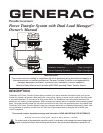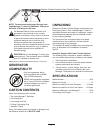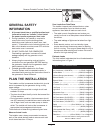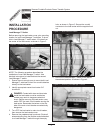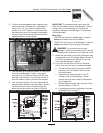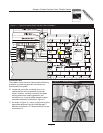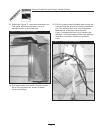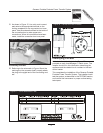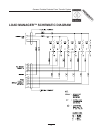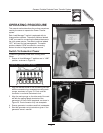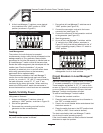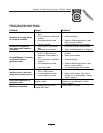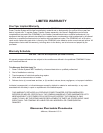
Generac Portable Products Power Transfer System
3
GENERAL SAFETY
INFORMATION
1. A licensed electrician or qualified professional
(referred to herein as installer) must install
the power transfer system per local code.
2. During installation, the installer is required to
remove the cover from the building power
distribution panel (referred to herein as a load
center.) To reduce the risk of electrical shock, the
Main circuit breaker must be turned OFF while the
load center cover is removed.
3. DO NOT OVERLOAD THE GENERATOR.
Overloading a generator in excess of its rated
wattage capacity will trip generator circuit
breakers.
4. Always plug the connecting cord set into the
connection box and generator BEFORE starting
the generator. Always shut the generator down
before detaching the cord set.
5. Portable generators attached to this Power
Transfer System must be operated outside, in
accordance with warnings and instructions found in
the generators Owners Manual.
PLAN THE INSTALLATION
The installer and the homeowner decide which circuits
are to be powered by the generator during a utility
power outage:
The plan should ensure that no single circuit load
exceeds 15 Amps.
The plan should also identify circuits that exceed the
15 Amp maximum.
During generator operation, the homeowner should
use only necessary household items and to alternate
use of larger loads, such as water pump or electric
skillet. The installer will instruct the homeowner in
appropriate load management techniques.
Three methods of determining loads are given here:
Measure Actual Loads
The installer uses a clamp-on ammeter to measure
each of the actual desired loads to ensure each total
circuit draws less than 15 Amps.
Sum Loads from Data Plates
The installer inspects each desired device, notes
current consumption found on labels on each
appliance, then adds all loads on each circuit:
The rated current of appliances and motors can
usually be found on a data plate or decal affixed to
the device.
The rated wattage of lights can be taken from light
bulbs.
Some electric motors, such as induction types,
require about three times more power for starting
than for running. This surge of power lasts for only a
few seconds when starting such motors. Be sure to
allow for this high starting load.
Estimate Loads
The third method estimates total circuit loads based on
information given in Figure 1.
APPLIANCE ~ ~ ~ ~ ~ ~ ~ ~ ~ ~ ~ ~ ~ ~ ~ ~LOAD DRAW
Air Conditioner (12,000 BTU) ~ ~ ~ ~ ~(1700W) 7A@240V
Coffee Maker ~ ~ ~ ~ ~ ~ ~ ~ ~ ~ ~ ~(1000W) 8.4A@120V
*Electric Range (one element) ~ ~ ~(1500W) 6.3A@240V
Electric Blanket ~ ~ ~ ~ ~ ~ ~ ~ ~ ~(1500W) 12.5A@120V
Electric Skillet ~ ~ ~ ~ ~ ~ ~ ~ ~ ~ ~(1250W) 10.5A@120V
*Freezer ~ ~ ~ ~ ~ ~ ~ ~ ~ ~ ~ ~ ~ ~ ~(500W) 4.2A@120V
*Furnace Fan (1/3 HP) ~ ~ ~ ~ ~ ~ ~(1200W) 10A@120V
*Jet Pump ~ ~ ~ ~ ~ ~ ~ ~ ~ ~ ~ ~ ~ ~(800W) 3.4A@240V
Light Bulb ~ ~ ~ ~ ~ ~ ~ ~ ~ ~ ~ ~ ~ ~(100W) 0.9A@120V
Microwave Oven ~ ~ ~ ~ ~ ~ ~ ~ ~ ~ ~(700W) 5.9A@120V
Oil Burner on Furnace ~ ~ ~ ~ ~ ~ ~ ~(300W) 2.5A@120V
Oil Fired Heater (30,000 BTU) ~ ~ ~ ~(150W) 1.3A@120V
Oil Fired Heater (85,000 BTU) ~ ~ ~ ~(225W) 1.9A@120V
Oil Fired Heater (140,000 BTU) ~ ~ ~(400W) 3.4A@120V
Radio ~ ~ ~ ~ ~ ~ ~ ~ ~ ~(50 to 200W) 0.5 to 1.7A@120V
*Refrigerator ~ ~ ~ ~ ~ ~ ~ ~ ~ ~ ~ ~ ~ ~(600W) 5A@120V
*Submersible Well Pump (1 HP) ~ ~(2000W) 8.4A@240V
Sump Pump ~ ~ ~ ~ ~ ~ ~ ~ ~ ~ ~ ~ ~ ~(600W) 5A@120V
Television ~ ~ ~ ~ ~ ~ ~ ~(200 to 500W) 1.7 to 4.2A@120V
* Allow 3 times the listed watts for starting these devices.
WATTS = AMPS x VOLTS
Figure 1 Load Reference Guide



